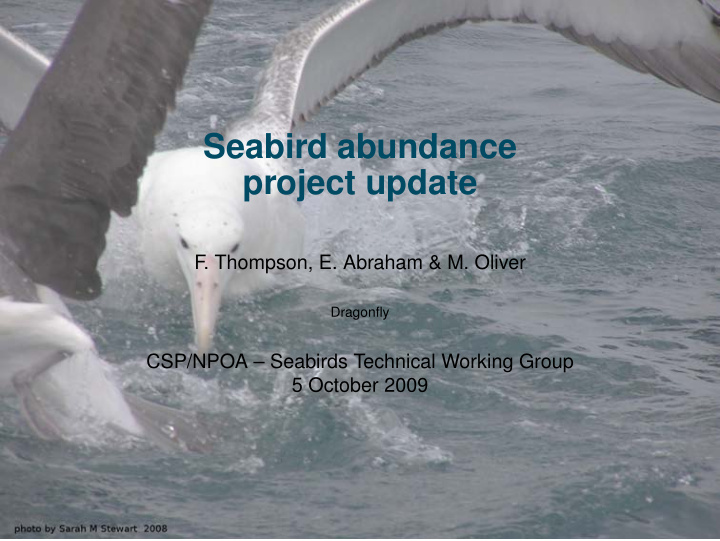



Seabird abundance project update F . Thompson, E. Abraham & M. Oliver Dragonfly CSP/NPOA – Seabirds Technical Working Group 5 October 2009
Outline Data collection and grooming 1 Diaries and forms Data entry Reconciliation Summary of data 2 Fisheries Observers Species distributions
Diaries and forms Data collection and grooming Seabird abundance observations • Observers on fishing vessels estimate sea bird abundance • Conducted for DOC by the MFish observer programme • Project has been running since 2000 • Initially data recorded in observer diaries • Also recorded on longline forms • Since 2005 data recorded on specially developed CSP forms
Diaries and forms Data collection and grooming
Diaries and forms Data collection and grooming
Diaries and forms Data collection and grooming Number of trips with data collected Longline Notebook CSP Total 2001 13 121 0 134 2002 4 112 0 116 2003 16 98 0 114 2004 50 100 0 150 2005 24 104 0 128 2006 13 48 62 123 2007 13 0 115 128 2008 10 0 152 162 2009 0 0 3 3 Total 143 583 332 1058 Years ending in June, with data from July 2000 to June 2008
Data entry Data collection and grooming Getting the data keyed • Forms since July 2004 have been keyed • and continue to be keyed as they come in • Data entry system developed (python, django) • The CSP developed forms have been double entered
Data entry Data collection and grooming
Data entry Data collection and grooming Abundance data keyed Trips keyed Forms Stations Obs. Once Multi 2004 48 0 68 791 4 056 2005 114 3 165 2 352 11 661 2006 66 49 178 2 677 14 511 2007 20 109 203 3 444 17 419 2008 11 136 376 5 895 26 114 2009 16 29 88 1 742 7 289 Total 275 326 1 078 16 901 81 050 Years ending in June.
Reconciliation Data collection and grooming • The abundance information keyed on CSP forms has been double entered to allow the data to reconciled • Each trip’s data has been viewed, and reconciled, using a custom grooming application • Data has been compared with the original forms as it has been reconciled
Reconciliation Data collection and grooming Error rates • 2130 corrections were made during reconciliation • 540 (0.7% of 77 756) abundance observations were added • 419 (0.5% of 77 756) abundance observations were corrected • 998 (5.9% of 17 047) station details were corrected • 171 (2.1% of 8038) species codes corrected • 2 (0.2% of 970) CSP trip key numbers corrected Linking to COD data • Using trip and event keys abundance observations were linked to the Central Observer Database (COD) data • Adds station data (latitude, longitude, target species etc.) • linked to trawl, surface longline, and bottom longline records
Fisheries Summary of data Number of trips by fishery Trawl Longline Total Squid Hoki Other Surface Bottom 2004 13 4 8 9 6 40 2005 23 22 38 6 19 108 2006 7 23 28 4 11 73 2007 17 9 39 11 9 85 2008 16 27 76 20 17 156 2009 17 21 7 1 46 Total 76 102 210 57 63 508 Note: 2009 forms continue to be keyed, and not all keyed forms have been reconciled.
Observers Summary of data Source of observer names • From the COD, we have the names of observers on each trip • We have defined ”the” observer as the more experienced of the two observers on each trip • There are 77 different observers in the data set
Species distributions Summary of data • White-capped albatross are distributed widely • includes the XWM and the XSY codes.
Species distributions Summary of data • Buller’s albatross are seen in large numbers in the Southern blue-fin tuna fishery • Widely distributed
Species distributions Summary of data • The Chatham albatross distribution is concentrated near the Chatham islands • Also seen in numbers on the Stewart-snares shelf
Species distributions Summary of data • White-chinned petrels are everywhere • Higher concentrations in the south
Species distributions Summary of data • Black petrels are concentrated in the Hauraki gulf • The observations in the south are probably due to observers miss interpreting the XBP code
Species distributions Summary of data • Do Westland petrels travel as far as North Cape and Cambpell Island?
Species distributions Summary of data • Widespread use of the unidentified petrel code
Recommend
More recommend